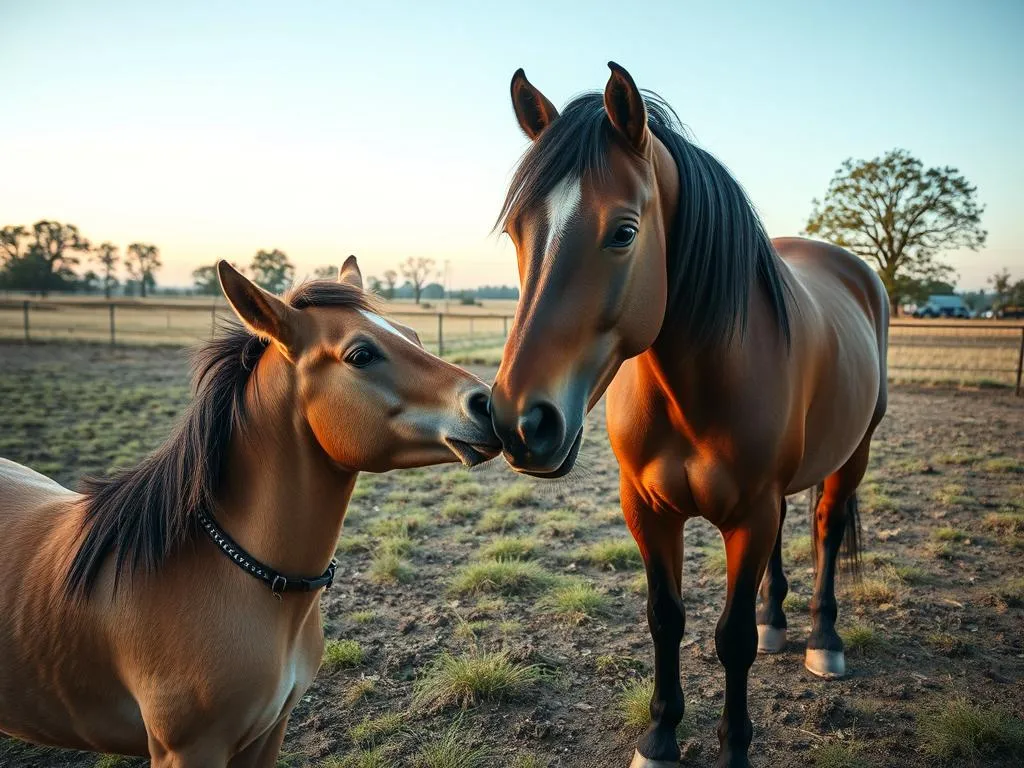
Introduction
Did you know that horses and dogs have coexisted alongside humans for thousands of years? In many cultures, these two species have worked together, often forming unique bonds that defy their natural instincts. Understanding the relationship between these two beloved animals is not only fascinating but also essential for pet owners and animal lovers alike.
In this article, we will explore the intriguing question: can horses and dogs be friends? We will delve into their behaviors, historical context, factors influencing friendship, signs of companionship, potential challenges, training tips, and real-life anecdotes. By the end of this article, you will have a comprehensive understanding of how these two species can coexist and thrive together.
Understanding Animal Behavior
Basic Instincts of Horses
Horses are social creatures that thrive in herds. Their natural instincts revolve around survival, and they rely heavily on their flight response. When faced with danger, horses will often flee rather than fight. This instinct plays a crucial role in their behavior, as they are always alert to potential threats in their environment.
Horses have a well-defined social structure within their herds. They form strong bonds with their companions, which can include other horses and even different species, such as dogs. Understanding this herd mentality is essential when considering whether horses and dogs can be friends.
Basic Instincts of Dogs
Dogs, on the other hand, are pack animals. They have a social hierarchy and are known for their loyalty and protective instincts. When dogs are in a pack, they establish roles that help maintain order and cohesion. This pack mentality is what makes dogs highly trainable and eager to please their owners.
A dog’s instinct to protect its family can sometimes lead to conflicts with other animals, especially if it perceives them as a threat. However, with proper training and socialization, many dogs can learn to accept and even bond with horses.
Communication Styles
Communication is key in the relationship between horses and dogs. Dogs communicate through a variety of methods, including body language, barking, and facial expressions. They often use their tails, ears, and posture to convey their feelings and intentions.
Horses, too, have their own methods of communication. They use whinnies, neighs, and various body movements to express themselves. Understanding these communication styles is crucial in fostering a friendship between the two species.
Historical Context
Relationship Between Horses and Dogs
The relationship between horses and dogs dates back to ancient times. Both animals were domesticated by humans for specific purposes: horses for transportation and labor, and dogs for herding and guarding. Over the centuries, their roles have evolved, but their companionship has remained a constant theme in human history.
Dogs have traditionally accompanied horses in various activities, such as herding livestock or guarding stables. This historical partnership sets the stage for the potential friendship between these two animals.
Cultural Significance
Throughout history, horses and dogs have appeared together in various cultures, symbolizing loyalty, bravery, and companionship. In mythology and folklore, many stories feature these animals as friends or allies. For instance, in Native American traditions, both dogs and horses are revered for their contributions to daily life and their deep emotional connections with humans.
Understanding this cultural significance can enhance our appreciation of the bond that can exist between horses and dogs.
Factors Influencing Friendship
Temperament and Personality
One of the most critical factors in determining whether horses and dogs can be friends is the individual temperament of each animal. Just as humans have unique personalities, so do dogs and horses.
Some dog breeds are more likely to get along with horses due to their temperament. For example, breeds like Golden Retrievers, Labrador Retrievers, and Australian Shepherds are known for their friendly and adaptable nature. Similarly, horses with calm dispositions are more likely to accept a dog as a companion.
Early Socialization
Early socialization is vital in fostering friendships between horses and dogs. Introducing a dog to a horse at a young age can help them develop a positive relationship. It is essential to expose both animals to each other in a controlled environment, allowing them to acclimatize to one another’s presence.
Here are some tips for socializing dogs and horses together:
- Start Slow: Introduce them in a safe, enclosed space.
- Positive Reinforcement: Reward both animals for calm behavior around each other.
- Monitor Interactions: Always supervise their interactions to ensure safety.
Environment and Space
The living conditions of both animals play a significant role in their ability to form a friendship. Horses require ample space to roam, while dogs need a secure area to play. A well-designed environment can facilitate positive interactions and reduce stress for both animals.
When creating a space for dogs and horses to interact, consider the following:
- Safe Fencing: Ensure that the area is securely fenced to prevent any escape or unwanted interaction.
- Separate Spaces: Provide separate areas for each animal to retreat to if they feel overwhelmed.
- Clear Boundaries: Establish clear boundaries to help both animals feel secure.
Signs of Friendship Between Horses and Dogs
Playful Interactions
One of the most delightful signs of friendship between horses and dogs is playful interactions. Horses and dogs can engage in various games, such as chasing each other or playing fetch. This playful behavior often indicates a strong bond between the two animals.
For example, a horse may nuzzle a dog, inviting it to play, while the dog may wag its tail excitedly, signaling its eagerness to engage. Observing these playful interactions is a clear indication that the two animals enjoy each other’s company.
Mutual Grooming and Affection
Mutual grooming is another sign of friendship. Horses often groom each other as a way to bond and show affection. Similarly, dogs may lick or nuzzle horses, which can signify trust and comfort. This grooming behavior is essential in establishing a strong emotional connection between the two animals.
Protective Behavior
Dogs are known for their protective instincts, and many will display this behavior towards horses they consider friends. There have been numerous anecdotes of dogs standing guard over their equine companions, ensuring their safety from potential threats. For instance, there are tales of dogs barking to alert horses of approaching dangers or even guiding them away from harm.
Potential Challenges
Predatory Instincts
While many dogs can form friendships with horses, it’s essential to recognize that some breeds may exhibit predatory behavior. Breeds with strong hunting instincts, such as Terriers and certain hounds, may view horses as prey rather than companions.
To mitigate this risk, it is crucial to take precautions when introducing the two animals. Always supervise their interactions and avoid situations where a dog may feel overly stimulated or threatened.
Territorial Behavior
Territorial instincts can also pose challenges in fostering friendships between horses and dogs. Dogs can become protective of their space, while horses may be territorial about their grazing areas or stalls. This territorial behavior can lead to conflicts if not managed appropriately.
To address territoriality, consider the following strategies:
- Establish Boundaries: Create distinct areas for each animal to reduce competition for space.
- Gradual Introduction: Allow both animals to acclimate to each other’s presence slowly.
- Positive Reinforcement: Reward calm behavior to encourage peaceful coexistence.
Health and Safety Concerns
Health and safety are paramount when considering friendships between horses and dogs. Injuries can occur if interactions are not monitored, and both animals can be susceptible to diseases that may be transmitted between species.
To ensure safe interactions, take the following precautions:
- Health Check: Ensure both animals are healthy and free from parasites or infections.
- Supervised Play: Always supervise their interactions to prevent accidents.
- Emergency Plan: Have a plan in place for emergencies, such as a vet visit, if needed.
Training and Socialization Tips
Basic Training for Dogs
Training is essential for fostering safe interactions between horses and dogs. Basic obedience training can help ensure that dogs respond to commands, making it easier to manage their behavior around horses.
Recommended commands include:
- Sit: Helps keep the dog calm.
- Stay: Prevents the dog from approaching the horse without permission.
- Leave It: Teaches the dog to ignore distractions.
Introducing the Two Animals
When introducing horses and dogs, a structured approach is vital for success. Here’s a step-by-step guide:
- Prepare a Safe Space: Choose a neutral area where both animals feel comfortable.
- Keep the Dog on a Leash: This allows for better control during the introduction.
- Observe Body Language: Watch for signs of stress, such as raised tails or pinned ears.
- Allow Sniffing: Let the dog sniff the horse from a safe distance, allowing both animals to familiarize themselves with each other.
- Gradual Approach: If both animals remain calm, gradually allow closer interactions while supervising closely.
Ongoing Socialization
Continued interactions are essential for maintaining the friendship between horses and dogs. Regularly scheduled playdates and joint activities can strengthen their bond.
Some activities that promote bonding include:
- Shared Exercise: Take both animals on walks or trail rides together.
- Training Sessions: Incorporate both animals in training exercises to reinforce positive behavior.
- Playtime: Encourage playful interactions in a safe environment.
Real-Life Examples and Anecdotes
Success Stories
Many pet owners have witnessed the incredible friendships that can form between horses and dogs. For instance, there are heartwarming stories of a Labrador Retriever named Max who befriended a gentle mare named Bella. Their bond grew over time, with Max often following Bella around the pasture, sharing snacks, and even enjoying calm moments together.
Lessons Learned
From these real-life experiences, we can glean valuable insights into what works and what doesn’t when fostering friendships between dogs and horses. One common theme is the importance of patience; relationships take time to develop. Additionally, consistent training and supervision are crucial in ensuring that both animals feel safe and comfortable.
Conclusion
In summary, the question of can horses and dogs be friends is met with a resounding yes. By understanding their instincts, communication styles, and the factors that influence their relationships, we can help these two species forge meaningful connections.
The potential for friendship between dogs and horses is not only possible but can lead to rewarding experiences for both animals and their owners. Embracing the uniqueness of each animal’s personality and providing a safe environment for interaction can pave the way for beautiful friendships that enhance the lives of both species.
As you consider the dynamics of your own pets, remember that fostering friendships between horses and dogs can lead to lifelong bonds filled with joy, play, and companionship.









